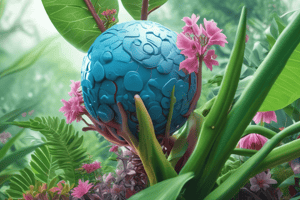Podcast
Questions and Answers
What is the role of photoreceptors like phototropins in plants?
What is the role of photoreceptors like phototropins in plants?
- Control the temperature around the plant
- Detect changes in light intensity and quality (correct)
- Secrete hormones for growth regulation
- Regulate mechanical responses in plants
How do plants respond to mechanical stimuli such as wind and water flow?
How do plants respond to mechanical stimuli such as wind and water flow?
- By secreting hormones for stress response
- By increasing their photosynthesis rate
- By detecting changes in temperature
- By swaying, bending, and changing their orientation (correct)
What is the significance of hormones like auxins in plants?
What is the significance of hormones like auxins in plants?
- Regulate various aspects of growth, development, and stress response (correct)
- Enhance the perception of light sources
- Control the reproduction process in plants
- Detect mechanical forces around the plant
Which environmental stimuli can plants perceive and respond to?
Which environmental stimuli can plants perceive and respond to?
What is the main purpose of phototropism in plants?
What is the main purpose of phototropism in plants?
How do plants benefit from thigmotropism?
How do plants benefit from thigmotropism?
What role does chemotropism play in plant movement?
What role does chemotropism play in plant movement?
How do plants respond to mechanical forces in thigmokinesis?
How do plants respond to mechanical forces in thigmokinesis?
Which statement best describes the significance of understanding plant sensitivity and movement?
Which statement best describes the significance of understanding plant sensitivity and movement?
Why is it important for scientists to study the mechanisms of plant movement?
Why is it important for scientists to study the mechanisms of plant movement?
Flashcards
Plant Sensitivity
Plant Sensitivity
The capacity of plants to detect and react to environmental factors.
Photoreceptors
Photoreceptors
Light receptors that enable plants to grow towards light.
Mechanical Stimuli Response
Mechanical Stimuli Response
Plant response to physical touch or wind.
Plant Hormones
Plant Hormones
Signup and view all the flashcards
Phototropism
Phototropism
Signup and view all the flashcards
Thigmotropism
Thigmotropism
Signup and view all the flashcards
Chemotropism
Chemotropism
Signup and view all the flashcards
Thigmokinesis
Thigmokinesis
Signup and view all the flashcards
Light Optimization (Plants)
Light Optimization (Plants)
Signup and view all the flashcards
Climbing Plants
Climbing Plants
Signup and view all the flashcards
Study Notes
Life Science: Exploring Sensitivity and Movement in Plants
Life science, a diverse field that encompasses the study of living organisms and their interactions, offers a wealth of fascinating discoveries, particularly in the realm of plant biology. This article delves into the intriguing topics of plant sensitivity and movement, highlighting their significance in the natural world.
Plant Sensitivity
Plants are incredibly sensitive organisms, able to perceive and respond to a variety of environmental stimuli — from light, temperature, and humidity to mechanical forces and even chemicals. These sensory systems enable plants to adapt to their environment, ensuring their survival and growth.
-
Light perception: Plants can perceive light from different sources, such as the sun, moonlight, and even artificial lights. Photoreceptors like phototropins, cryptochromes, and phytochromes detect changes in light intensity and quality, enabling plants to grow and orient themselves in response.
-
Mechanical stimuli: Plants can respond to tactile forces like wind, water flow, and even animal disturbances. These responses include swaying, bending, and changing the orientation of plant structures (such as leaves and stems) to avoid damage.
-
Hormonal signaling: Plants secrete hormones (such as auxins, gibberellins, and abscisic acid) that regulate various aspects of growth, development, and stress response. These hormones play a crucial role in plant sensitivity and movement.
-
Chemical signals: Plants can detect chemical signals from their environment, including those produced by other plants, animals, and microorganisms. These signals can trigger a variety of responses, such as attraction, repulsion, and protection.
Plant Movement
Movement in plants is not as overt as in animals, but plants have evolved a number of sophisticated mechanisms to move and respond to their environment.
-
Phototropism: Plants can move towards or away from light sources. This movement, driven by the differential growth of cells in the stem and leaves, allows plants to follow light sources and optimize their photosynthetic efficiency.
-
Thigmotropism: Some plants can move in response to mechanical stimuli, such as twining and coiling vines. These movements enable plants to optimize their exposure to light, minimize self-shading, and reduce damage from wind and other forces.
-
Chemotropism: Plants can move in response to chemical signals, such as the root's ability to grow towards nutrient sources. This movement enables plants to optimize their access to vital nutrients and water.
-
Thigmokinesis: Plants can respond to mechanical forces, such as the touch of wind or water flow, by altering their growth patterns to minimize damage. Thigmokinesis is a form of plant movement that helps plants adapt to their environment and enhance their survival.
Understanding these mechanisms of plant sensitivity and movement can reveal a great deal about the natural world and its intricate web of interactions. By studying these processes, scientists can develop new technologies and strategies to improve agriculture, horticulture, and environmental conservation.
Studying That Suits You
Use AI to generate personalized quizzes and flashcards to suit your learning preferences.




